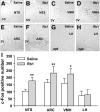Antiobesity and antihyperglycemic effects of ginsenoside Rb1 in rats
- PMID: 20682695
- PMCID: PMC3279544
- DOI: 10.2337/db10-0315
Antiobesity and antihyperglycemic effects of ginsenoside Rb1 in rats
Abstract
Objective: Obesity and type 2 diabetes are national and worldwide epidemics. Because currently available antiobesity and antidiabetic drugs have limited efficacy and/or safety concerns, identifying new medicinal agents, such as ginsenoside Rb1 (Rb1) as reported here, offers exciting possibilities for future development of successful antiobesity and antidiabetic therapies.
Research design and methods: Changes in feeding behavior after acute intraperitoneal administration of Rb1 and the effects of intraperitoneal Rb1 for 4 weeks on body weight, energy expenditure, and glucose tolerance in high-fat diet (HFD)-induced obese rats were assessed. We also examined the effects of Rb1 on signaling pathways and neuropeptides in the hypothalamus.
Results: Acute intraperitoneal Rb1 dose-dependently suppressed food intake without eliciting signs of toxicity. This inhibitory effect on feeding may be mediated by central mechanisms because Rb1 stimulated c-Fos expression in brain areas involved in energy homeostasis. Consistent with this, Rb1 activated the phosphatidylinositol 3-kinase/Akt signaling pathway and inhibited NPY gene expression in the hypothalamus. Four-week administration of Rb1 significantly reduced food intake, body weight gain, and body fat content and increased energy expenditure in HFD-induced obese rats. Rb1 also significantly decreased fasting blood glucose and improved glucose tolerance, and these effects were greater than those observed in pair-fed rats, suggesting that although Rb1's antihyperglycemic effect is partially attributable to reduced food intake and body weight; there may be additional effects of Rb1 on glucose homeostasis.
Conclusions: These results identify Rb1 as an antiobesity and antihyperglycemic agent.
Figures






Similar articles
-
Central inflammation and leptin resistance are attenuated by ginsenoside Rb1 treatment in obese mice fed a high-fat diet.PLoS One. 2014 Mar 27;9(3):e92618. doi: 10.1371/journal.pone.0092618. eCollection 2014. PLoS One. 2014. PMID: 24675731 Free PMC article.
-
Ginsenoside Rb1 as an Anti-Diabetic Agent and Its Underlying Mechanism Analysis.Cells. 2019 Feb 28;8(3):204. doi: 10.3390/cells8030204. Cells. 2019. PMID: 30823412 Free PMC article. Review.
-
Anti-obesity Effects of Ginsenosides in High-Fat Diet-Fed Rats.Chin J Integr Med. 2019 Dec;25(12):895-901. doi: 10.1007/s11655-019-3200-x. Epub 2019 May 30. Chin J Integr Med. 2019. PMID: 31144161
-
Gut vagal afferents are necessary for the eating-suppressive effect of intraperitoneally administered ginsenoside Rb1 in rats.Physiol Behav. 2015 Dec 1;152(Pt A):62-7. doi: 10.1016/j.physbeh.2015.09.012. Epub 2015 Sep 15. Physiol Behav. 2015. PMID: 26384952 Free PMC article.
-
Models and strategies in the development of antiobesity drugs.Vet Pathol. 2014 May;51(3):695-706. doi: 10.1177/0300985813492801. Epub 2013 Jul 16. Vet Pathol. 2014. PMID: 23860008 Review.
Cited by
-
Ginsenoside Rb1 improves intestinal aging via regulating the expression of sirtuins in the intestinal epithelium and modulating the gut microbiota of mice.Front Pharmacol. 2022 Sep 27;13:991597. doi: 10.3389/fphar.2022.991597. eCollection 2022. Front Pharmacol. 2022. PMID: 36238549 Free PMC article.
-
Inhibitory Effects of Ginsenoside Rb1 on Early Atherosclerosis in ApoE-/- Mice via Inhibition of Apoptosis and Enhancing Autophagy.Molecules. 2018 Nov 8;23(11):2912. doi: 10.3390/molecules23112912. Molecules. 2018. PMID: 30413028 Free PMC article.
-
Central inflammation and leptin resistance are attenuated by ginsenoside Rb1 treatment in obese mice fed a high-fat diet.PLoS One. 2014 Mar 27;9(3):e92618. doi: 10.1371/journal.pone.0092618. eCollection 2014. PLoS One. 2014. PMID: 24675731 Free PMC article.
-
Ginsenoside Rb1 as an Anti-Diabetic Agent and Its Underlying Mechanism Analysis.Cells. 2019 Feb 28;8(3):204. doi: 10.3390/cells8030204. Cells. 2019. PMID: 30823412 Free PMC article. Review.
-
Ginseng-plus-Bai-Hu-Tang ameliorates diet-induced obesity, hepatic steatosis, and insulin resistance in mice.J Ginseng Res. 2020 Mar;44(2):238-246. doi: 10.1016/j.jgr.2018.10.005. Epub 2018 Oct 27. J Ginseng Res. 2020. PMID: 32148405 Free PMC article.
References
-
- Blumenthal M, Ferrier GKL. Total sales of herbal supplements in United States show steady growth. Herbal Gram 2006;71:64–66
-
- Court WE. Ginseng: The Genus Panax. Amsterdam, the Netherlands, Harwood Academic Publishers; 2006;71:64–66
-
- Wang XY, Zhang JT. Effect of ginsenoside Rb1 on mouse sexual function and its mechanism. Acta Pharm Sin 2002;35:492–495
-
- Kim DY, Chang JC. Radioprotective effect of ginseng components on antioxidant enzymes, glutathione and lipid peroxidation of liver in irradiated mice. Korean J Ginseng Sci 1998;22:1–10
-
- Lee FC. Facts about Ginseng, the Elixir of Life. Elizabeth, NJ, Hollyn International, 1992
Publication types
MeSH terms
Substances
Grants and funding
LinkOut - more resources
Full Text Sources
Medical
Miscellaneous

